BUICK RIVIERA 1993 Owners Manual
Manufacturer: BUICK, Model Year: 1993, Model line: RIVIERA, Model: BUICK RIVIERA 1993Pages: 324, PDF Size: 16.01 MB
Page 151 of 324
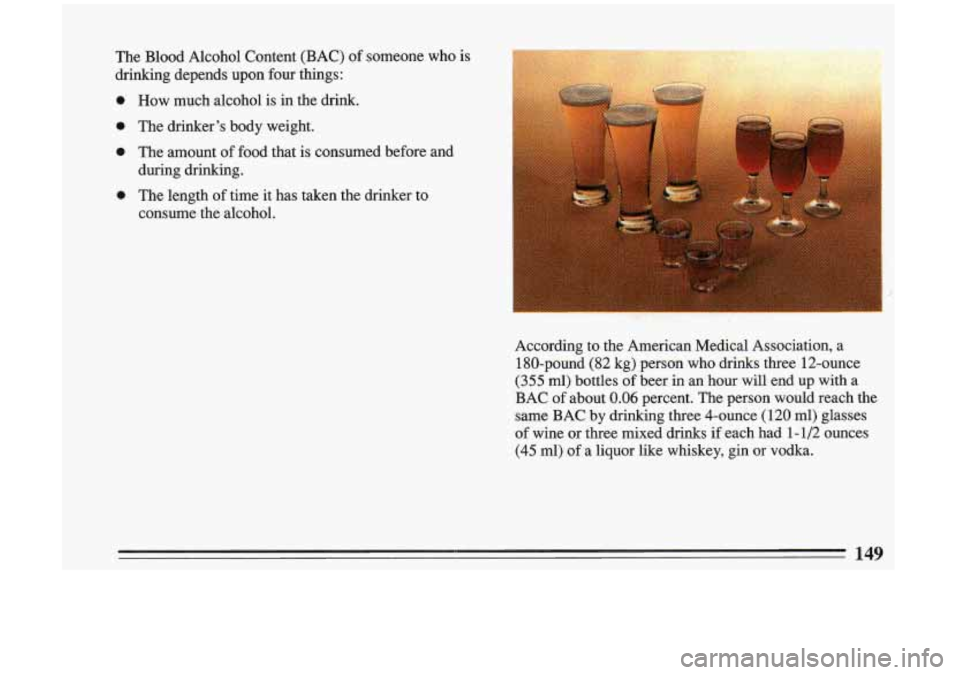
The Blood Alcohol Content (BAC) of someone who is
drinking depends upon four things:
0 How much alcohol is in the drink.
0 The drinker’s body weight.
0 The amount of food that is consumed before and
during drinking.
consume the alcohol.
0 The length of time it has taken the drinker to
According to the American Medical Association, a
180-pound (82 kg) person who drinks three 12-ounce
(355 ml) bottles of beer in an hour will end up with a
BAC of about 0.06 percent. The person would reach the
same BAC by drinking three 4-ounce (120 ml) glasses
of wine or three mixed drinks
if each had 1 - 1/2 ounces
(45 ml) of a liquor like whiskey, gin or vodka.
149
Page 152 of 324
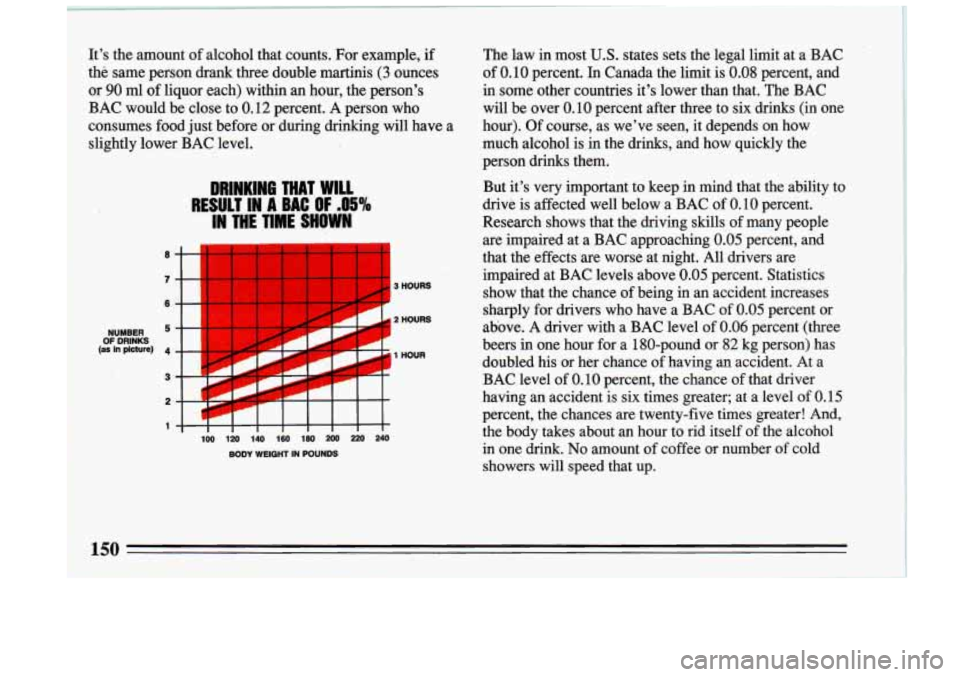
It’s the amount of alcohol that counts. For example, if
the same person drank three double martinis (3 ounces
or
90 ml of liquor each) within an hour, the person’s
BAC would be close to
0.12 percent. A person who
consumes food just before or during drinking will have a
,slightly lower BAC, level.
DRINKING THAT WILL
RESULT IN A BAC OF .05%
IN THE TIME
.:i= 6 - - ’
I
OF DRINKS (as In picture) 4
‘IOURS
1 HOUR
PI I’
‘t , , -1 ,I !j-/j
1
100 120 140 160 180 200 220 240
BODY WEIGHT IN POUNDS
The law in most U.S. states sets the legal limit at a BAC
of
0.10 percent. In Canada the limit is 0.08 percent, and
in some other countries it’s lower than that. The BAC
will be over
0.10 percent after three to six drinks (in one
hour). Of course, as we’ve seen, it depends on how
much alcohol is in the drinks, and how quickly the
person drinks them.
But it’s very important to keep in mind that the ability t\
o
drive is affected well below a BAC of
0.10 percent.
Research shows that the driving skills of many people
are impaired at a BAC approaching
0.05 percent, and
that the effects are worse at night. All drivers are
impaired at BAC levels above
0.05 percent. Statistics
show that the chance
of being in an accident increases
sharply for drivers who have a BAC of
0.05 percent or
above. A driver with a BAC level of
0.06 percent (three
beers in one hour for a 180-pound or
82 kg person) has
doubled his or her chance of having
an accident. At a
BAC level of
0.10 percent, the chance of that driver
having an accident is six times greater; at a level of
0.15
percent, the chances are twenty-five times greater! And,
the body takes about an hour to rid itself of the alcohol
in one drink.
No amount of coffee or number of cold
showers will speed that up.
Page 153 of 324
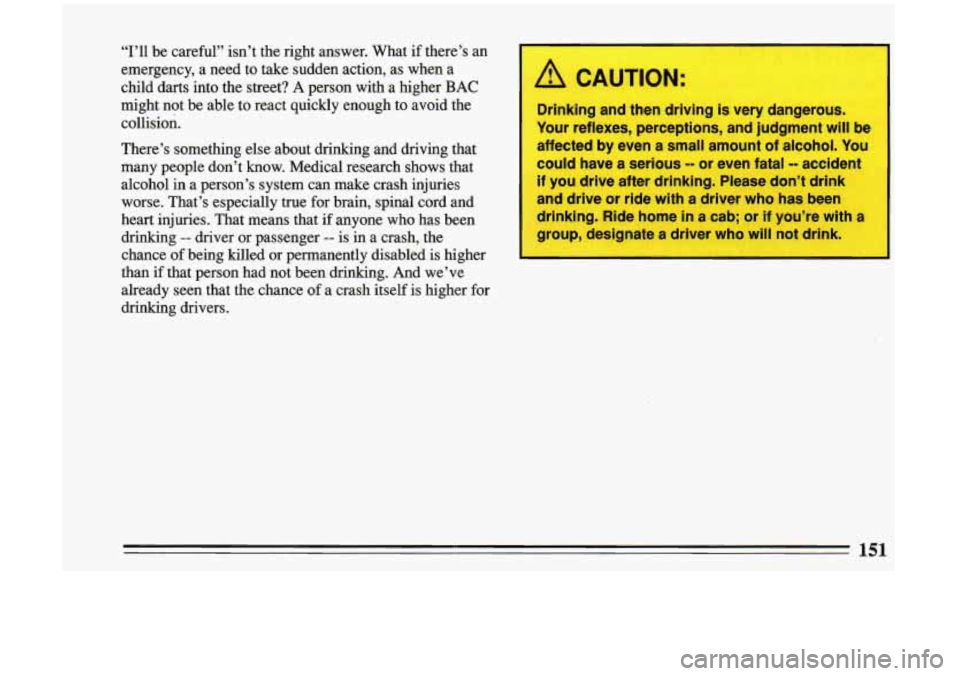
“I’ll be careful” isn’t the right answer. What if there’s an
emergency, a need to take sudden action, as when a
child darts into the street?
A person with a higher BAC
might not be able to react quickly enough to avoid the
collision.
There’s something else about drinking and driving that
many people don’t know. Medical research shows that
alcohol in a person’s system can make crash injuries
worse. That’s especially true for brain, spinal cord and
heart injuries. That means that
if anyone who has been
drinking
-- driver or passenger -- is in a crash, the
chance of being killed
or permanently disabled is higher
than
if that person had not been drinking. And we’ve
already seen that the chance of a crash itself is higher for
drinking drivers.
151
Page 154 of 324
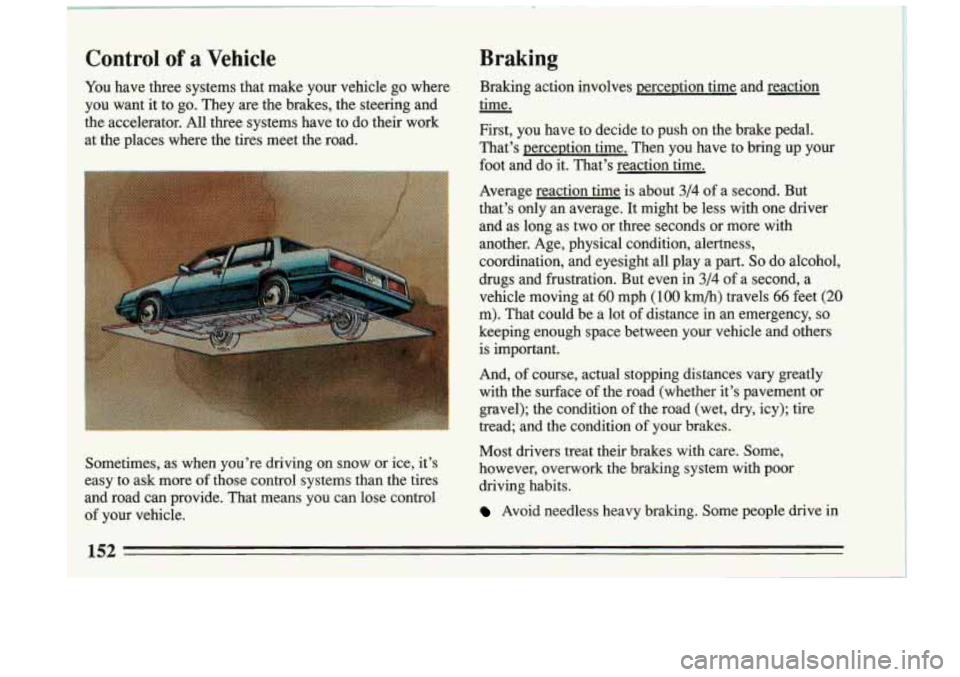
Control of a Vehicle Braking
You
have three systems that make your vehicle go where Braking act\
ion involves perception time and reaction
you want it to go. They are the brakes, the steering and time.
the accelerator. All three systems have to do their work First\
,
you have to decide to push on the brake pedal,
at the places where the tires meet the road.
That’s perception time. Then you have to bring up your
foot and do
it. That’s reaction time.
Average reaction time is about
3/4 of a second. But
that’s only an average. It might be less with one driver
and as long as two or three seconds or more with
another. Age, physical condition, alertness,
coordination, and eyesight all play a part.
So do alcohol,
drugs and frustration. But even in
3/4 of a second, a
~ vehicle moving at 60 mph (100 km/h) travels 66 feet (20
m). That could be a lot of distance in an emergency, so
keeping enough space between your vehicle and others
is important.
Sometimes, as when you’re driving on snow or ice, it’s
easy to ask more
of those control systems than the tires
and road can provide. That means you can lose control
of your vehicle.
~ And, of course, actual stopping distances vary greatly
with the surface of the road (whether it’s pavement or
gravel); the condition
of the road (wet, dry, icy); tire
tread; and the condition of
your brakes.
Most drivers treat their brakes with care. Some,
however, overwork the braking system with poor
driving habits.
Avoid needless heavy braking. Some people drive in
152
Page 155 of 324
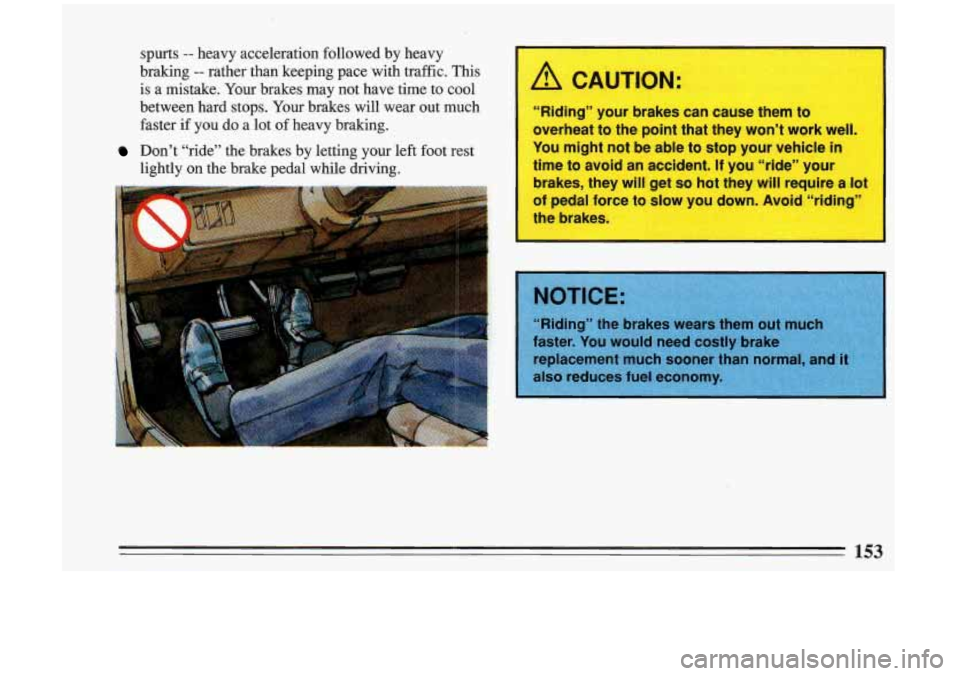
spurts -- heavy acceleration followed by heavy
braking
-- rather than keeping pace ‘with traffic. This
is a mistake. Your brakes may not have time to cool
between hard stops. Your brakes will wear out much
faster
if you do a lot of heavy braking.
Don’t “ride” the brakes by letting your left foot rest
lightly on the brake pedal while driving.
I
A CAUTION:
“Riding” your brakes can cause them to
overheat to the point that they won’t work well.
You might not be able to stop your vehicle in
time to avoid an accident. If you “ride” your
brakes, they will get
so hot they will require a lot
of pedal force to slow you down. Avoid “riding”
the brakes.
I
I
153
Page 156 of 324
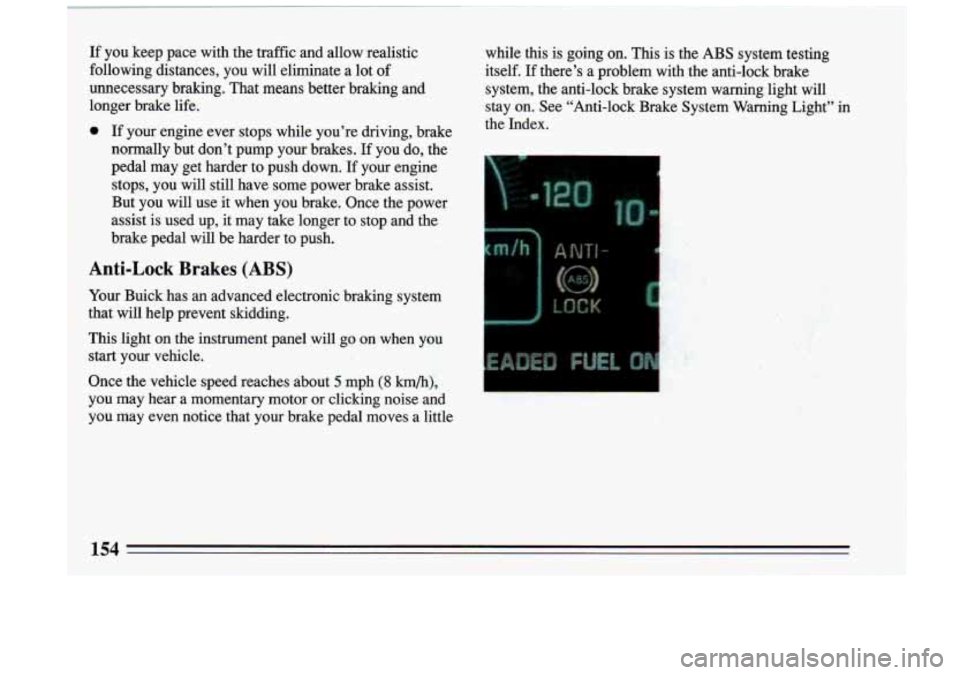
T
Page 157 of 324
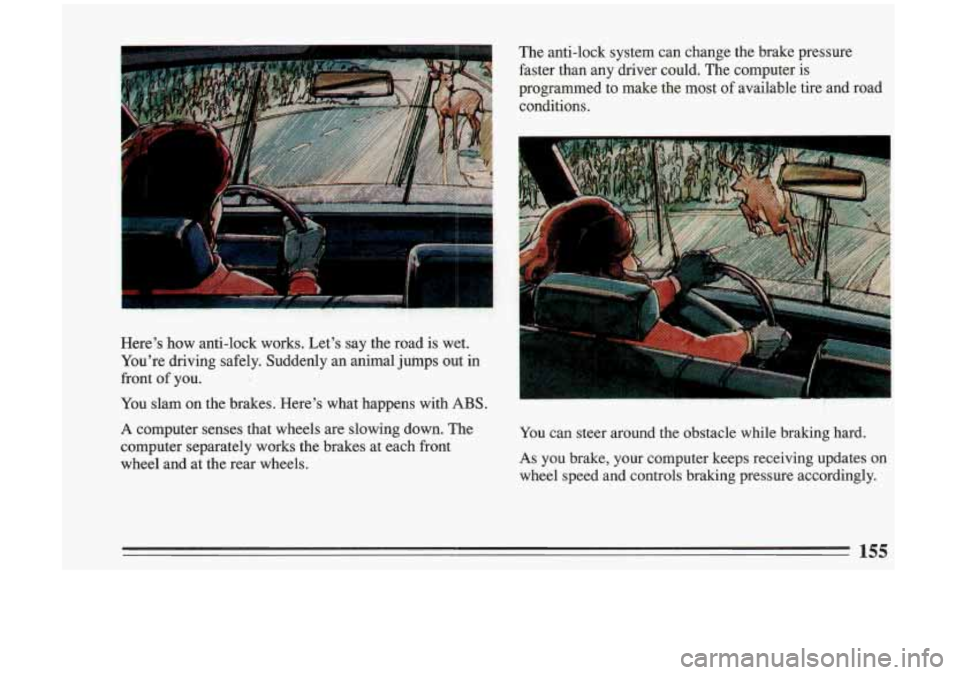
Here’s how anti-lock works. Let’s say the road is wet.
You’re driving safely. Suddenly an animal jumps out in
front
of you.
You slam on the brakes. Here’s what happens with
ABS.
A computer senses that wheels are slowing down. The
computer separately works the brakes at each front
wheel and at the rear wheels. You
can steer around the obstacle while braking hard.
As you brake, your computer keeps receiving updates on
wheel speed and controls braking pressure accordingly.
155
Page 158 of 324
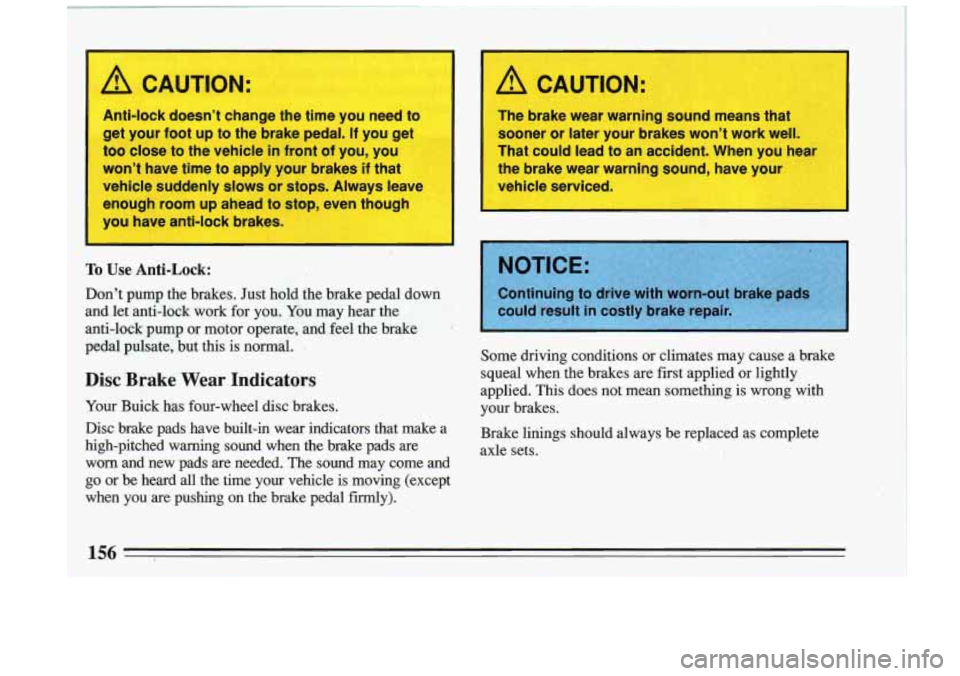
I A CAUTION:
Anti-lock doesn’t change the time you need to
get your foot up
to the brake pedal. If you get
too close to the vehicle in front of you, you
won’t have time to apply your brakes
if that
vehicle suddenly slows or stops. Always leave
enough room up ahead to stop, even though
you have anti-lock brakes.
. 5 ’,.
To Use Anti-Lock:
Don’t pump the brakes. Just hold the brake pedal down
and let anti-lock work for you. You may hear the
anti-lock pump or motor operate, and feel the brake
pedal pulsate, but this is normal.
.
Disc Brake Wear Indicators
Your Buick has four-wheel disc brakes.
Disc brake pads have built-in wear indicators that make a
high-pitched warning sound when the brake pads are worn and new pads are needed. The sound may come and
go or
be heard all the time your vehicle is moving (except
when you are pushing on the brake pedal firmly).
I ‘
A CAUTION:
The brake wear warning sound means that
sooner or later your brakes won’t work well.
That could lead to an accident. When you hear
the brake wear warning sound, have your
:~
vehicle serviced. &tz
some driving conditions or climates may cause a brake
squeal when the brakes are first applied or lightly
applied.
This does not mean something is wrong with
your brakes.
Brake linings should always be replaced as complete
axle sets.
156
Page 159 of 324
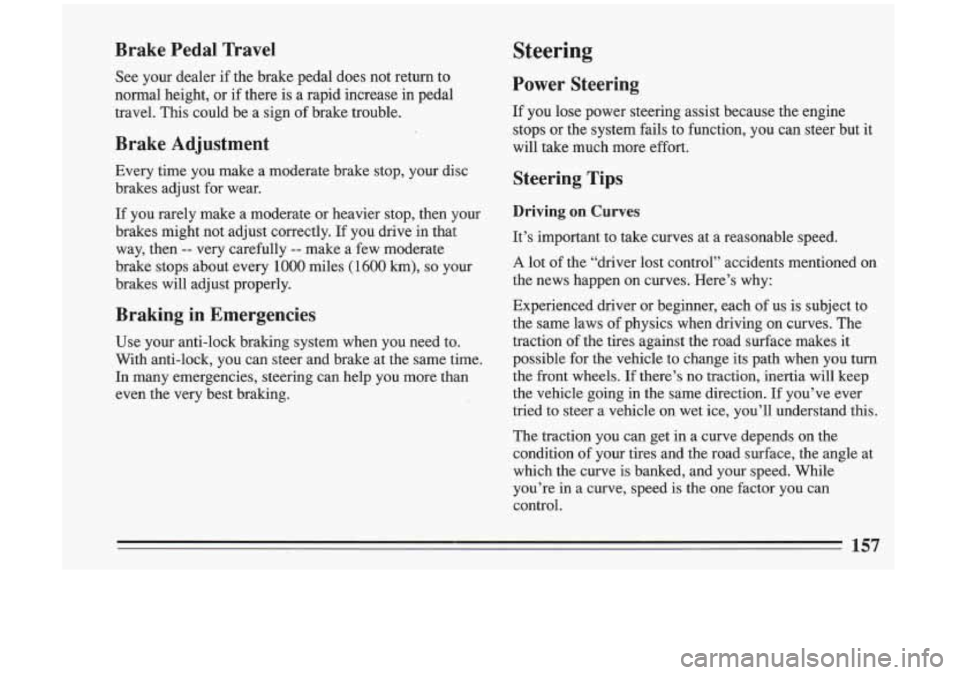
Brake Pedal Travel
See your dealer if the brake pedal does not return to
normal height, or if there is a rapid increase in pedal
travel. This could be
a sign of brake trouble.
Brake Adjustment
Every time you make a moderate brake stop, your disc
brakes adjust for wear.
If you rarely make a moderate or heavier stop, then your
brakes might not adjust correctly.
If you drive in that
way, then
-- very carefully -- make a few moderate
brake stops about every
1000 miles ( 1600 km), so your
brakes will adjust properly.
Braking in Emergencies
Use your anti-lock braking system when you need to.
With anti-lock, you can steer and brake at the same time.
In many emergencies, steering can help you more than
even the very best braking.
Steering
Power Steering
If you lose power steering assist because the engine
stops or the system fails to function, you can steer but it
will take much more
effort.
Steering Tips
Driving on Curves
It’s important to take curves at a reasonable speed.
A lot of the “driver lost control” accidents mentioned on
the news happen on curves. Here’s why:
Experienced driver or beginner, each of us is subject to
the same laws of physics when driving on curves. The
traction
of the tires against the road surface makes it
possible for the vehicle to change its path when you turn
the front wheels.
If there’s no traction, inertia will keep
the vehicle going
in the same direction. If you’ve ever
tried to steer a vehicle on wet ice, you’ll understand this.
The traction you can get in a curve depends on the
condition of your tires and the road surface, the angle at
which the curve is banked, and your speed. While
you’re in a curve, speed is the one factor you can
control.
157
Page 160 of 324
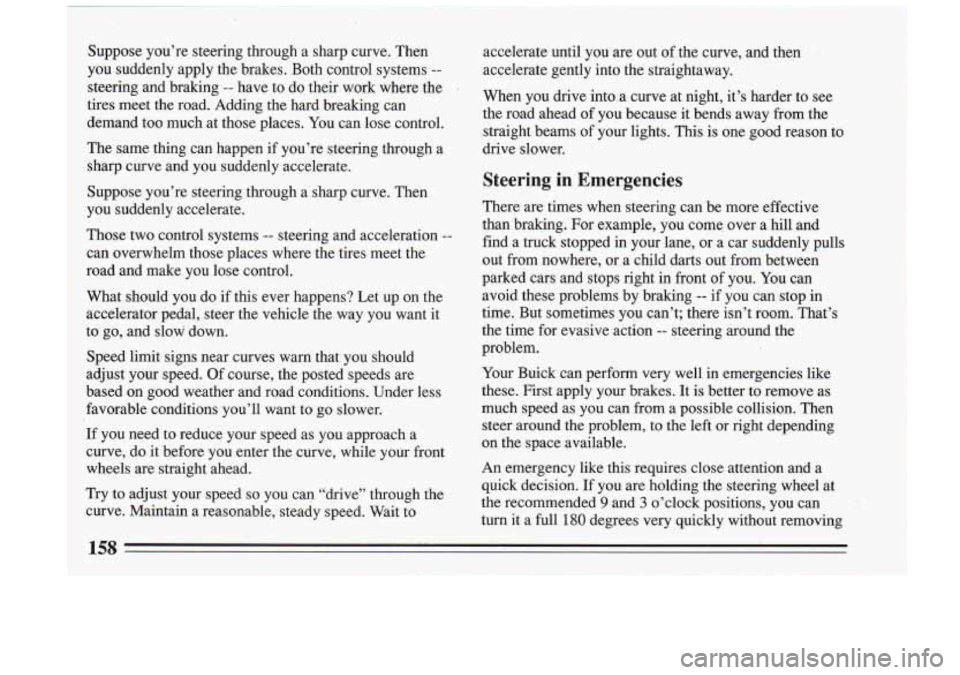
158